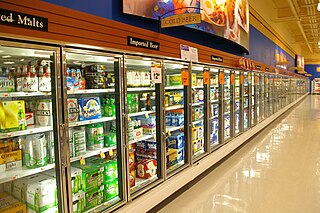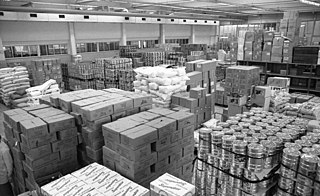
Refrigeration is any of various types of cooling of a space, substance, or system to lower and/or maintain its temperature below the ambient one. Refrigeration is an artificial, or human-made, cooling method.

Freezing food preserves it from the time it is prepared to the time it is eaten. Since early times, farmers, fishermen, and trappers have preserved grains and produce in unheated buildings during the winter season. Freezing food slows decomposition by turning residual moisture into ice, inhibiting the growth of most bacterial species. In the food commodity industry, there are two processes: mechanical and cryogenic. The freezing kinetics is important to preserve the food quality and texture. Quicker freezing generates smaller ice crystals and maintains cellular structure. Cryogenic freezing is the quickest freezing technology available due to the ultra low liquid nitrogen temperature −196 °C (−320 °F).

A refrigerator, commonly fridge, is a commercial and home appliance consisting of a thermally insulated compartment and a heat pump that transfers heat from its inside to its external environment so that its inside is cooled to a temperature below the room temperature. Refrigeration is an essential food storage technique around the world. The low temperature reduces the reproduction rate of bacteria, so the refrigerator lowers the rate of spoilage. A refrigerator maintains a temperature a few degrees above the freezing point of water. The optimal temperature range for perishable food storage is 3 to 5 °C. A freezer is a specialized refrigerator, or portion of a refrigerator, that maintains its contents’ temperature below the freezing point of water. The refrigerator replaced the icebox, which had been a common household appliance for almost a century and a half. The United States Food and Drug Administration recommends that the refrigerator be kept at or below 4 °C (40 °F) and that the freezer be regulated at −18 °C (0 °F).

Kegerator, a portmanteau of the words keg and refrigerator, is a refrigerator that has been designed or altered to store and dispense from kegs.
Auto-defrost, automatic defrost or self-defrosting is a technique which regularly defrosts the evaporator in a refrigerator or freezer. Appliances using this technique are often called frost free, frostless, or no-frost.

An ice pack or gel pack is a portable bag filled with water, refrigerant gel, or liquid, meant to provide cooling. They can be divided into the reusable type, which works as a thermal mass and requires freezing, or the instant type, which cools itself down using chemicals but can only be used once. The instant type is generally limited to medical use as a cold compress to alleviate the pain of minor injuries, while the reusable type is both used as a cold compress and to keep food cool in portable coolers or in insulated shipping containers to keep products cool during transport.

A cold chain is a supply chain that uses refrigeration to maintain perishable goods, such as pharmaceuticals, produce or other goods that are temperature sensitive. Common goods, sometimes called, called cool cargo, distributed in cold chains include fresh agricultural produce, seafood, frozen food, photographic film, chemicals, and pharmaceutical products. The objective of a cold chain is to preserve the integrity and quality of goods such as pharmaceutical products or perishable good from production to consumption.

The Solar Electric Light Fund (SELF) is a non-profit organization whose mission is to design, fund and implement solar energy solutions to benefit those in poor rural communities without access to an electrical grid. This allows students to study at night and brings computers and Internet into schools. It makes it possible to bring in water for irrigation without having to hand-carry it long distances, allowing women to spend their time on money-earning enterprises. Access to electricity and water improves health care. SELF has completed several projects in more than 20 countries including a solar powered drip irrigation in Benin, a health care center in Haiti, telemedicine in the Amazon rainforest, online learning platform in South Africa, and a microenterprise development in Nigeria.

An icemaker, ice generator, or ice machine may refer to either a consumer device for making ice, found inside a home freezer; a stand-alone appliance for making ice, or an industrial machine for making ice on a large scale. The term "ice machine" usually refers to the stand-alone appliance.

A pot-in-pot refrigerator, clay pot cooler or zeer is an evaporative cooling refrigeration device which does not use electricity. It uses a porous outer clay pot containing an inner pot within which the food is placed. The evaporation of the outer liquid draws heat from the inner pot. The device can cool any substance, and requires only a flow of relatively dry air and a source of water.
The Expanded Program on Immunization(EPI) in the Philippines began in 1976 through Presidential Decree No. 996 signed by President Ferdinand Marcos. And, in 1986, made a response to the Universal Child Immunization goal. The four major strategies include:
- sustaining high routine Full Immunized Child (FIC) coverage of at least 90% in all provinces and cities;
- sustaining the polio-free country for global certification;
- eliminating measles by 2008; and
- eliminating neonatal tetanus by 2008.

A solar-powered refrigerator is a refrigerator which runs on energy directly provided by sun, and may include photovoltaic or solar thermal energy.

Food storage containers are widespread in use throughout the world and have probably been in use since the first human civilizations.

A refrigerator death is death by suffocation in a refrigerator or other air-tight appliance. Because, by design, such appliances are air-tight when closed, a person entrapped inside will have a low supply of oxygen. Early refrigerators could only be opened from the outside, making accidental entrapment a possibility, particularly of children playing with discarded appliances; many such deaths have been recorded. Modern designs close with a magnetic mechanism that can be opened from the inside, reducing the danger of accidental entrapment.
Sure Chill Technology is a cooling technology that is currently being used in medical refrigerators, but is thought to have wider potential in the future for domestic refrigerators and beverage coolers. According to BBC, the refrigerator's temperature 'can stay at 4°C for more than 10 days without power, and is used mainly in Africa' to store vaccines and other medical supplies. It can be powered by electricity or solar, and uses the physics of water to store energy, thus not relying on batteries.
PfSPZ Vaccine is a metabolically active non-replicating whole sporozoite (SPZ) malaria vaccine being developed by Sanaria against Plasmodium falciparum (Pf) malaria. Clinical trials have been safe, extremely well tolerated and highly efficacious. The first generation PfSPZ product is attenuated by gamma irradiation; the second generation vaccines PfSPZ-CVac and PfSPZ LARC2 are, respectively, attenuated chemically and genetically. Multiple studies are ongoing with trials of the PfSPZ vaccines. All three products are produced using the same manufacturing process. These products are stored and distributed below -150 °C using liquid nitrogen (LN2) vapor phase (LNVP) freezers and cryoshippers.
DTwP-HepB-Hib vaccine is a 5-in-1 combination vaccine with five individual vaccines conjugated into one. It protects against diphtheria, tetanus, whooping cough, hepatitis B and Haemophilus influenzae type B, which is generally used in middle- and low-income countries, where polio vaccine is given separately.

An ultra low temperature (ULT) freezer is a refrigerator that stores contents at −80 to −86 °C. An ultra low temperature freezer is commonly referred to as a "minus 80 freezer" or a "negative 80 freezer", referring to the most common temperature standard. ULT freezers come in upright and chest freezer formats.
Many vaccines require refrigeration to remain active, and the lack of infrastructure to maintain the cool chain to reliably bring vaccines into more remote areas of developing countries poses a serious challenge to national immunization programs. Portable vaccine cooler units have been proposed by several technologists. The WHO Performance, Quality and Safety (PQS) programme is a driver of the technology.

Vaccine storage relates to the proper vaccine storage and handling practices from their manufacture to the administration in people. The general standard is the 2–8 °C cold chain for vaccine storage and transportation. This is used for all current US Food and Drug Administration (FDA)-licensed human vaccines and in low and middle-income countries. Exceptions include some vaccines for smallpox, chickenpox, shingles and one of the measles, mumps, and rubella II vaccines, which are transported between −25 °C and −15 °C. Some vaccines, such as the COVID-19 vaccine, require a cooler temperature between −80 °C and −60 °C for storage.














